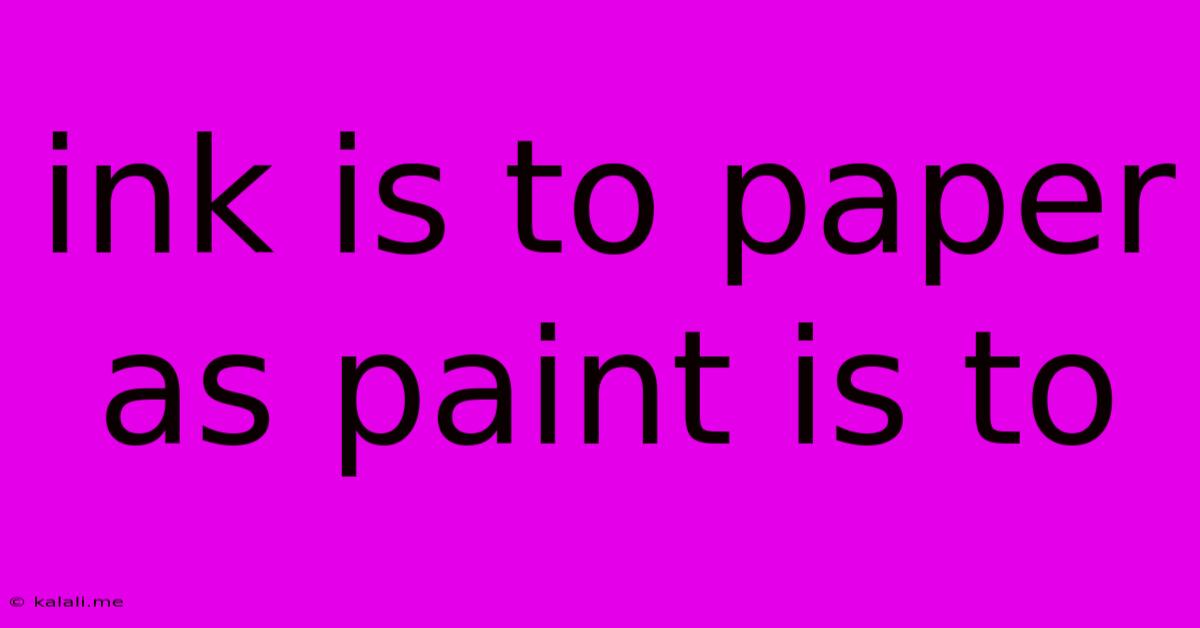Ink Is To Paper As Paint Is To
Kalali
Jun 13, 2025 · 3 min read

Table of Contents
Ink is to Paper as Paint is to… What? Exploring Analogous Relationships
What's the connection between ink and paper? It's a classic analogy: ink is the medium used to create marks on paper, its substrate. This simple relationship sparks a fascinating question: ink is to paper as paint is to… what? The answer isn't as straightforward as you might think, and delving into it opens a world of artistic exploration and creative possibilities. This article will explore the various analogous relationships, considering different types of paint and their corresponding surfaces.
This post will explore the multifaceted relationship between paint and its receptive surfaces, delving into the nuances of different paint types and their optimal substrates. We'll also examine the artistic considerations that inform these choices, highlighting the importance of achieving the desired aesthetic and technical outcome.
Canvas: The Classic Pairing
The most immediate and widely recognized answer is canvas. For centuries, artists have used canvas, stretched and primed, as the ideal surface for oil paints, acrylics, and even watercolors in some instances. The textured surface of the canvas allows for a unique interaction with the paint, enabling techniques like impasto (thick application of paint) that would be impossible on smoother surfaces. The absorbency of the canvas also plays a crucial role in how the paint dries and adheres. Considering the longevity and durability of both canvas and oil paints, this pairing represents a strong and traditional analogous relationship.
Walls: Murals and More
Moving beyond the confines of the studio, we find that walls provide another significant analogous pairing. From ancient cave paintings to modern-day murals, walls have served as expansive canvases for artists throughout history. The scale and permanence of wall paintings necessitate specific paint types, often durable and weather-resistant formulations. The surface preparation of the wall is also critical, impacting the adhesion and longevity of the artwork. Different types of paint, including fresco, tempera, and modern acrylics, are suitable for wall applications depending on the desired aesthetic and durability.
Wood Panels: Rich Texture and Detail
Wood panels, another popular substrate, offer a unique combination of texture and stability. The grain of the wood provides subtle variations in surface, influencing the way the paint interacts and appears. Oil paints have long been favored for wood panels, as the absorption and grain characteristics contribute to a rich and complex final look. Preparing wood panels properly, including priming, is vital to ensure optimal adhesion and prevent the paint from being absorbed too quickly.
Paper: Watercolor's Ideal Companion
While we started with ink on paper, it's important to acknowledge the analogous relationship between paper and watercolor paints. Watercolor's delicate nature necessitates a paper type that can absorb the water and pigment without buckling or tearing. The texture and weight of the watercolor paper are crucial factors, influencing the overall look and feel of the finished artwork. Different paper weights and textures offer diverse painting experiences.
Other Surfaces: Beyond the Traditional
The relationship isn't limited to these traditional surfaces. Paint can be applied to a wide variety of substrates, including:
- Metal: Creating metallic surfaces with detailed, durable designs
- Glass: Producing translucent or opaque effects with stained glass or acrylic paints.
- Fabric: Using fabric paints for unique textile creations.
- Stone: For outdoor sculptures and murals requiring durability against weathering.
Ultimately, the answer to "ink is to paper as paint is to…" is multifaceted and depends heavily on the type of paint being considered. The key takeaway is the interplay between the medium and the substrate, a dynamic relationship that shapes the artist's creative vision and the final aesthetic outcome. Exploring these relationships allows for a deeper understanding of artistic techniques and the diverse possibilities available to the creative mind.
Latest Posts
Latest Posts
-
Which Of The Following Is A Nonrenewable Energy Source
Jun 14, 2025
-
What Planet Is Known As The Morning Star
Jun 14, 2025
-
Gpa Requirements For Utah State University
Jun 14, 2025
-
Given Wxyz What Is The Measure Of Z
Jun 14, 2025
-
Which Of The Following Statements Is True Of A Group
Jun 14, 2025
Related Post
Thank you for visiting our website which covers about Ink Is To Paper As Paint Is To . We hope the information provided has been useful to you. Feel free to contact us if you have any questions or need further assistance. See you next time and don't miss to bookmark.